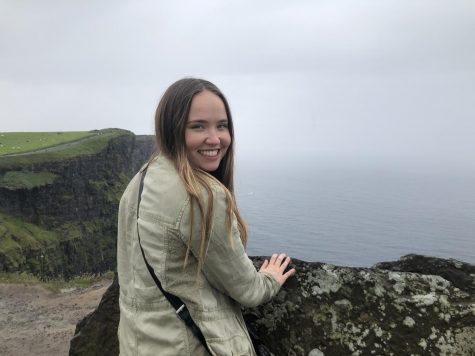From the inside looking out: A ride-along with GVPD
Oct 14, 2019
Following the final whistle of the Battle of the Valleys football game Oct. 12, fireworks shot through the air, marking Grand Valley State University’s victory over Saginaw Valley State University. While the players’ jobs were done for the day, the night was just heating up for those who work at the Grand Valley Police Department.
After escorting SVSU coach Ryan Brady off the field, GVPD Captain Jeff Stoll welcomed us to the station. There, the officers regrouped before beginning the nightly patrol. Stoll led the police sergeants through a discussion about what went well during the game and what needs improvement. The officers emphasized safety measures like stolen signs, unlocked gates and improved traffic flow.
After the meeting, calls began to flood in. Some calls were lower priority for GVPD, such as students locked out of off-campus housing and medical calls for non-students in Ottawa County. But a call from Holton-Hooker Living Center detailing an intoxicated student passed out and unresponsive summoned several GVPD vehicles to the scene.
When we arrived with Stoll and Sergeant Leah Heaton, students began to file out of the dorm room to wait in the common area down the hall. The student was lying unconscious on the floor. Heaton began shaking him and trying to wake him up. She checked his pulse and pupils while Stoll spoke with the student’s friends about what he had been drinking. After about 10 minutes, EMTs arrived at the scene, and the student was lifted onto a stretcher and taken to the hospital. The student was under the age of 21, but he is protected under amnesty law, which exempts underage drinkers from criminal liability when help is called. This law is one of the ways GVPD works to protect student safety.
“The amnesty law is in place to try and encourage people to call the police so they can get help,” Stoll said. “So in this case, that person is not going to get an MIP because his friends sought out treatment…officers, police and subsequently the ambulance to try and get him help.”
After returning to the police station, a suspected intoxicated driver was accompanied by Ottawa County sheriffs after driving a work vehicle into the woods by 8th Avenue and I-96. The driver refused a Breathalyzer test at the scene, which led officers to believe both alcohol and drugs were involved.
Stoll, who is a certified drug recognition expert, prepared the test kit which can detect a variety of drugs from an oral swab. At the department, the driver agreed to a Breathalyzer, and the test resulted in a blood alcohol content of .23, nearly three times the legal level. Because alcohol was present, the drug test was unnecessary; driving under the influence covers both drug and alcohol intoxication.
“There was no reason for me to do the evaluation,” Stoll said. “It does not matter what else is in his system, there is no additional charge.”
Campus quieted down around 12:30 a.m., when we patrolled student housing for unsafe driving and potential hazards. After driving through Campus View, Canvas and Mystic Woods apartments, Stoll and Heaton observed several crowded bus stops and watched for students who looked like they were intoxicated or in danger.
“When you’re working at night it’s really to make sure that people are safe. Enforcement is another component, but there is a focal area of being safe,” Stoll said. “So when we see (people on the sidewalk), we want to make sure that they’re walking in a straight line, not going to fall over, coherent enough.”
Stoll said that the bus system gives students an alternative to driving, ridesharing or walking, which cuts back on drunk driving numbers and unsafe situations. Stoll said that in the past 10 years, drunk driving incidents have decreased.
Despite these lowering statistics, we attended a drunk driving incident around 1:45 a.m. The driver, who was underaged, had already taken a Breathalyzer test and was over the legal limit. Heaton performed a pat-down on the handcuffed student and placed her back in the police vehicle. Another officer inspected her car and recovered two bottles of Svedka, a bottle of Malibu, a bottle of Fireball and about 20 unopened Smirnoff Ice bottles. A majority of the liquor bottles were full.
After trying to speak with the student, Officer Ryan Ykimoff noticed that she was having a panic attack. He led her through breathing exercises and tried to calm her down before continuing the process. She was taken to Ottawa County Jail, where she was kept until she sobered up.
Around 2:15 a.m., we attended a marijuana call at Kistler Living Center where we accompanied Officer Madeline Brewer outside while she wrote up a ticket. During this time, a group of students approached Stoll and asked if he could help with a potential stolen phone at an off-campus party. After writing down details about the incident, another officer was called to give the students his undivided attention. Throughout the encounter, the officers proved to be very approachable and were happy to help the students.
“We’re just people,” Heaton said after the incident.
While there is a stigma about police officers being intimidating and unapproachable, GVPD is working to break that misconception. By creating strong relationships with on-campus Resident Assistants and students, GVPD aims to further protect Lakers.
Throughout the night, GVPD officers were focused on safety. Two traffic stops for failure to yield at an intersection and no headlights resulted in warnings to ensure the drivers’ safety.
At around 2:45 a.m., with throwback hits on the radio, we returned to the station. After over five hours of shadowing and observing Stoll and Heaton, we noticed their continued focus on students’ safety.
On the outside, it’s easy to feel threatened by the red flashing lights, but inside the cruiser, GVPD has proven that it can be a humanizing experience to be on call.
























